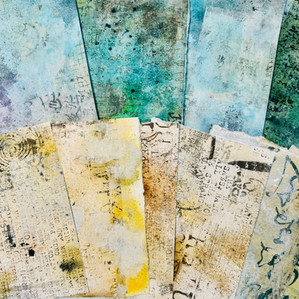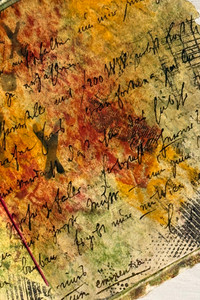Exploring Dye Sprays in Mixed Media: My Favorite Inks for Art Journals, Fabric & Book Covers (2025)
- Melanie Grant

- Jul 17
- 3 min read
Updated: Jul 23
TRANQUIL • LUMINOUS • ROOTED
Stories from the studio, reflections on process, and the art of the handmade.
The Magic of Dye Sprays in My Mixed Media Practice
This year, I’ve found myself deep in exploration with a medium that’s relatively new to me: dye sprays. What began as simple curiosity quickly turned into a season of experimentation—spraying, blending, layering, and lifting color on everything from paper to fabric.
After spending countless hours watching how these inks move, settle, and react, I wanted to share the tools I’ve grown to love—and how I use them in my mixed media work.
Over time, I’ve developed a particular fondness for three dye spray lines: Distress Oxide Sprays by Tim Holtz, Dylusions Ink Sprays by Dyan Reaveley and Izink Dye Sprays curated by Seth Apter. Each brings its own personality to the creative table. All of these sprays can be purchased on multiple online platforms as well as brick and mortar retail outlets.
Distress Oxide Sprays: Chalky, Reactive, and Rich
These are a beautiful marriage of pigment and dye. The pigment adds opacity, while the dye brings in rich color that shifts and oxidizes when water is added. You’ll first notice a slight change in hue, followed by a soft hazing that dries to a chalk-like texture.
This is the spray I use when I want a layered, aged look—something weathered, time-worn, and full of drama. They’re also wonderfully reactive when layered over other media like acrylic and chalk paint or other sprays.
Dylusions Ink Sprays: Vibrant, Fluid, and Transparent
Created for porous surfaces, Dylusions sprays are vivid and saturated. Their dye-based formula gives brilliant pops of color that seep into paper, wood, canvas, even clay. I often use these to build luminous backgrounds in art journals or to stain fabric with a translucent wash.
Because they’re water-soluble, layering these sprays on top of each other or over different pigments creates unexpected blends and new colors. A yellow spray over blue might become a glowing green; a hot pink over teal can shift toward a soft violet.
Izink Dye Sprays by Seth Apter: Matte, Blended, and Artful
These French-made inks are highly pigmented and dry to a soft matte finish. They’re ideal for spraying directly onto paper or for lifting blended pools of color off a gel plate. I appreciate how intentional these colors feel—curated with a mixed-media artist’s eye for depth and range.
The ink can be misted, brushed, or sponged, offering flexibility across surfaces. And because they dry quickly, they work well for layering techniques or detailed mixed media compositions.
Why I Keep Coming Back to Dye Sprays
All of these sprays are water-reactive, which means that every time I add water, blot, brayer, or blend—I’m participating in a conversation with the materials. When combined with acrylic or chalk paints, the results become even more layered and dimensional. The pigments shift, merge, puddle, and halo in unexpected ways. The final surface often feels weathered or timeworn—like something unearthed rather than newly made.
I use dye sprays on:
Khadi paper (for journal pages and book covers)
Fabric, either directly or through gel plate printing
Art journals and collage work
Gel plate prints, often layered with acrylic or chalk paints
Surfaces prepped or finished with other paint media
Because these sprays remain water-soluble, I always apply a fixative when working on finished pieces—especially book covers or fabric—to protect the surface and preserve the layered effects. Whether it’s a soft wash of color or a richly pigmented buildup, sealing helps lock in the movement and ensure durability.
One of my favorite ways to work with them is on the gel plate, where I can manipulate color even further. I often use stencils to create pattern and depth, then either pull a print or lift the design onto paper or fabric. Sometimes I apply the sprays with a brayer to spread pigment more evenly across the surface or to achieve a soft background glow.
Final Thoughts
If you're new to dye sprays like I was, give yourself room to play. Pick one or two and try them on different surfaces. Mist them, layer them, blot them, brayer them and add water—Then let the pigments react and reveal—each spray moves with its own rhythm, transforming the surface in ways you couldn’t plan even if you tried!
And that, my friends, is why I return to them again and again. Try them for yourself—and don’t be surprised if they find a permanent place in your practice and studio.
Let’s Keep the Conversation Going
Are you a fellow maker who uses Dye Sprays? I’d love to hear about your techniques and favorite practices. Leave a comment or connect with me on Instagram @melaniegrantdesign.
Curious where these dye sprays show up next? Join my mailing list to see the finished pieces and get first access to new releases.
















Comments